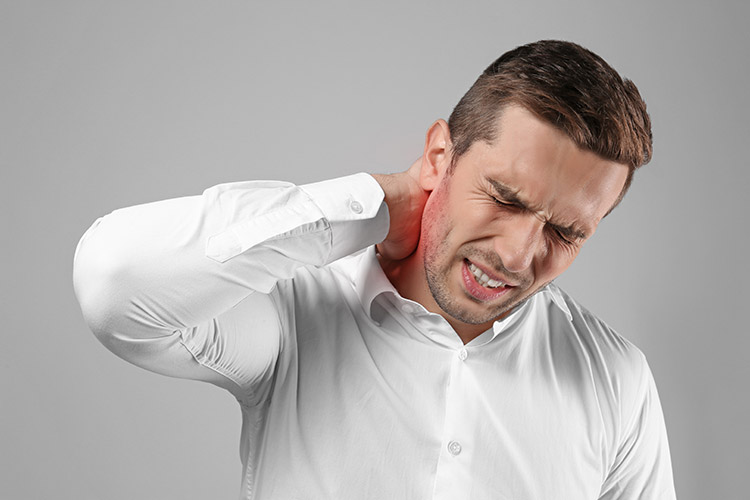Neck pain can last from just a few days to several years, depending on the cause. Some of the most common causes are osteoarthritis, spinal stenosis, ruptured discs, pinched nerves, physical and mental stress, poor posture, tumors, and other health conditions.
What Exactly Is Neck Pain?
Neck pain is defined as pain on or in the cervical spine below your head. Neck pain is a common symptom of a range of illnesses and injuries.
It’s possible that you have an axial neck ache. This can be acute (lasting a few days to up to six weeks) or chronic (lasting longer than that).
If left untreated, neck pain can disrupt everyday activities and lower your quality of life.
Neck Pain Affects A Wide Range of People
Neck pain is a relatively common occurrence. Yearly, it affects one out of every three persons. It affects more women than males and your chances of getting it rise as you become older.
What Does It Feel Like To Have Neck Pain?

Some people have described the discomfort as follows:
- An ache that never goes away.
- A piercing or burning sensation.
- Mild pressure on the neck that causes increased sensitivity.
- Numbness and tingling inside one or both arms, as well as neck pain.
- Neck muscles are tense/tightening more than usual.
What Could Be Causing Your Neck Pain?
Neck discomfort can be caused by a variety of medical conditions and injuries. Neck pain can be caused by a variety of factors such as:
Aging: As you get older, degenerative disorders like osteoarthritis (weakening of joint cartilage), as well as nerve damage (narrowing of spinal spaces), can cause neck pain. Stress as well as motion can cause disc degeneration in the spine, resulting in disc herniation or nerve impingement.
Injury: Pain and soreness can result from a quick directional movement of the head or neck followed by a rebound motion in the opposite direction (whiplash). Trauma can cause injuries in the muscle, ligaments, discs, vertebral joints, and nerve roots in the neck’s spinal cord.
Physical strain: Stiffness and soreness can result from overusing your neck during repetitive tasks or strenuous exercises.
Spinal imbalance affected by the following conditions: Being overweight, having weak abdominal muscles, and having terrible posture (standing for long periods of time; improper computer/keyboard/chair positioning) can all impact spine posture as well as contribute to neck pain.
Growth: Tumors, cysts, and bone spurs are all examples of growths that can create neck pain in rare circumstances.
Health conditions: Meningitis, rheumatoid arthritis, and cancer are examples of other illnesses.
What Is The Procedure For Determining The Cause Of Neck Pain?
A health assessment and medical history are used by doctors to identify neck pain. To detect pain and motion concerns, your physician will feel as well as move your neck. Your physical strength and reflexes are also tested. Your doctor will inquire about prior neck problems, such as whiplash or disk herniation. Your doctor could also about your job or any other activities that might cause neck pain.
Your doctor may ask for imaging tests such as X-rays, magnetic resonance imaging (MRI), or computed tomography to determine the origin of your discomfort (CT). These tests can reveal damage to your neck’s bones and surrounding tissues, as well as other concerns.
Electromyographic (EMG), nerve conduction studies, myelogram, and/or nerve root block are some of the other tests your doctor may request. These examine the discs in the spine itself, the nerves, as well as muscle reaction and the source of the pain in greater detail.
What Is The Best Way To Manage or Cure Neck Pain?
The treatment for neck discomfort varies depending on the cause. Its purpose is to reduce discomfort while increasing function. These are some of the most commonly prescribed medications for this issue:
- NSAIDs (nonsteroidal anti-inflammatory drugs) are used to treat pain and inflammation, while muscle relaxants help the body repair.
- Physical therapy is effective.
- TENS works by interrupting the pain messages with a reduced electrical charge administered to the skin’s surface that reaches the nerves that cause the pain.
- To alleviate discomfort, inflatable devices can be used.
- Steroid injections all around spinal nerves are used to assist relieve pain and inflammation.
- Surgery to repair or fuse several vertebrae in the spine after they have been crushed or injured.

What Should I Do At Home To Ease Neck Pain?
Your doctor can advise you on how to relieve neck discomfort at home. These suggestions may include the following:
- Using hot or cold packs to relieve pain.
- Stretching or exercising in a moderately.
- Using over-the-counter analgesics like aspirin or ibuprofen to ease pain and inflammation.
- Resting.
- Stopping physical activities for the time being.
Long-term neck pain relief treatments include:
- Stop smoking. Smoking wreaks havoc on bone structure and hinders the healing process.
- Weight loss in case of being overweight.
- Reduce your level of anxiety. Exercise, walk, meditate, get a massage, or try a yoga class.
- Improve your shoulder and neck muscles with exercises.
When Should I See A Doctor If I’m Experiencing Neck Pain?
If your neck pain is interfering with your work or other everyday routines, see your doctor.
Neck discomfort can be a symptom of a medical crisis in some circumstances. If you have neck pain, see a doctor right once if:
- After an accident, this condition develops.
- Numbness or tingling in the arms, shoulder, or legs is a symptom.
- Leg weakness or impaired coordination in the arms or legs are symptoms.
- Headaches, dizziness, vomiting, or nausea are examples of symptoms.
- It is characterized by a loss of bowel and bladder control.
- This is accompanied by stiffness.
- Chills, fever, or unexpected weight loss are common symptoms.
- When you’re resting or moving, and the pain stays the same.
- Over-the-counter drugs are ineffective.
- After one week, there is no improvement.










